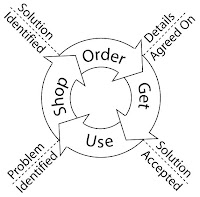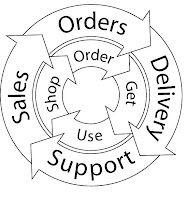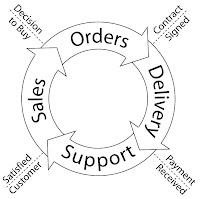The 5 Fundamental Benefits
For any business to be successful, the people inside the business must understand why people would want their products or services. Understanding the 5 reasons people ask for help, and the 5 corresponding benefits they receive is critical to understanding what type of help you should offer.
I was brought up in a very small town where we learned to do most things for ourselves. My father seemed able to fix anything that broke, and build anything we needed. We tuned our own bicycles, replaced engines in our cars, we even built onto our house and added a garage. I learned that it was good to be able to do things for yourself. I feel very fortunate to have learned how to do so many things for myself from my dad.
What took me a little longer to figure out was when to ask for help. It was rare that my father needed to ask for help, so I began to see asking for help as a type of failure. I felt bad if I could not do something myself. Looking back now I realize there were many times my father asked for help (and many more my mother wishes he would have). When he did it was not a sign of failure, it was a sign of intelligence. He asked for help for some very good, basic reasons. The same reasons everyone asks for help if they are smart.
1. Don't know how to do something
Sometimes you plain don’t know how to do something. This applies to business just like it does to every day life. There are things that you don’t need to do every day, and you just never learn to do them. What’s the solution, get some help. Of course you could always go out and learn how to do it yourself, but usually its far better to just get some help from someone who already knows.
If you don’t know how to do something, your best bet is to find someone who has that knowledge and get it done right by an expert.
2. Don't have the time
I don’t know about you, but my list of things to do is always longer than my available time. To top it off, I don’t want to spend all of my available time working on to-do lists. Just because you know how to do something, doesn’t mean you have the time to do it.
If you don’t have the time to do something that needs to be done, you need to find someone who does have the time and free up your time for things that matter to you.
3. Don't have the tools
I spent a year work in residential construction, still one of the best jobs I ever had. I worked with two brothers who were great fun, and treated me well. We used a lot of tools on the job, but when it came time to put the roof on a building we always called a local crane owner-operator to come over and give us a hand for a few hours. He would hoist the roof trusses up, and we would nail them in place one by one. We asked for his help because he had a special tool that we did not, a crane, and he knew how to use it safely and efficiently.
Sometimes you can rent the tools. Sometimes it’s best if the tools come with someone who knows how to use them.
If you don’t have the tools to do a job, you need to find someone who has the right tools to get the job done.
4. Don't Want To Do It
Sometimes we come across things that we just don’t want to do. As a youth I changed the oil in my car myself. I don’t do it any more. I know how. It wouldn’t take me any longer than it does to go to the lube place and wait for them to do it. I have all the tools sitting in my garage. I just don’t like doing it anymore so I go to the lube shop and pay them to do it for me. I’m glad they’re there. They provide me with a valuable service.
There is always someone out there to help you with these things. They may like doing it, they may like you, or they may just want your business. In any case, helping people with things they don’t like doing is a great service.
If you have something you don’t want to do, you can always find someone who does. Let someone else worry about the things you don’t like doing.
5. More efficient to have someone else do it
Every person and business has certain things they do very well. This is generally because they have some combination of knowledge, time, tools, and desire that other people don’t have. Because they are so good at it they become very efficient and can often do things two times, ten times or even a hundred times faster than the average person. It is well worth paying someone twice what you think your own time is worth to get something done if they can do it ten times faster than you.
If someone else can do to faster and cheaper than you, it makes sense to let them do it. Having something done by someone efficient can save you tons of time and money.
ConclusionThere are 5 basic reasons people get help:
1. Don't know how to do it
2. Don't have the time
3. Don't have the tools
4. Don't want to do it
5. More efficient to have someone else do it
And consequently there are 5 basic service benefits that can be offered:
1. Get it done right by an expert
2. Free up your time for things that matter to you
3. The right tools to get the job done
4. Let us worry about that for you
5. Save your time and money
Providing a good service improves the quality of people’s lives. The better you understand people’s reasons for wanting help, the better equipped you are to help them. Remember every successful business helps themselves by helping others.






